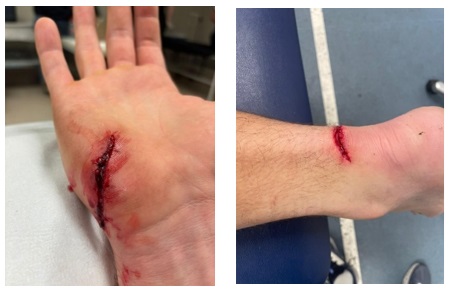Wounds and lacerations
A laceration is a burst wound caused by blunt trauma. An incised wound is caused by a sharp item contacting and injuring the skin. Most rugby wounds are lacerations, but occasional incised wounds can occur.
Rugby allows medical staff the opportunity to cover or close wounds sustained during a match to prevent the wound from getting worse and to stem bleeding that may be a risk for other players.
Wounds on the pitch, are however, sustained in a fast-moving and unclean environment with a high potential for contamination with soil, rubber crumb or sweat. Wounds may be more significant than an "on-the-run" on-pitch assessment allows. The medic should therefore always try to see beyond the simplicity of wound closure. It is vital to recognise wounds that are deeper than they first appear or that involve injury to key structures (around the face or hand or over joints) or are that are heavily contaminated with pitch debris.
A bold decision to close these and allow the player to continue may result in much greater problems for the player with formal washouts in the operating room, frank infection and longer time loss from the sport, if the wound is hiding deep contamination or injury to other structures.
All decisions around wound closure should therefore be carefully considered and closure should be performed in an environment with appropriate lighting, equipment and washing facilities, to enable appropriate assessment and washout.
It is better to send a player with a wound to hospital and to have it simply washed out and closed in a better facility such as the Emergency Department rather than closeing it at the stadium only for the player to need it re-opened and washed out in the operating room a few days later. Given that experience and judgement are the key skills in deciding whether to close a wound in the rugby environment, the practicalities of technical wound closure are not covered here.
There is of course a small but significant risk to other players of blood-born virus exposure from a bleeding wound and areas such as vaccination and screening should be considered in line with local policy as well as diligently ensuring wounds are adequately covered and blood and blood stained clothing is appropriately washed away and changed.
 Some wounds are in parts of the body with complex anatomy or close to major structures and careful consideration should be given about the merits of closing versus being left open and properly washed out and explored in hospital. e.g., Palm of hand or over large tendons, as opposed to a simple brow wound.
Some wounds are in parts of the body with complex anatomy or close to major structures and careful consideration should be given about the merits of closing versus being left open and properly washed out and explored in hospital. e.g., Palm of hand or over large tendons, as opposed to a simple brow wound.